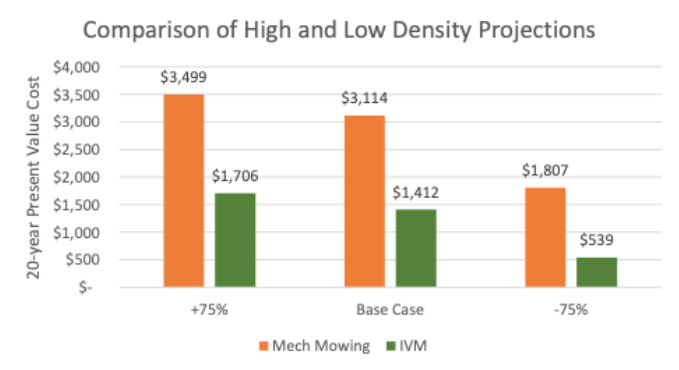The integration of physical and chemical control methods is recognized as a best practice across the vegetation management industry. In addition to improving control of incompatible plant species to promote the development of biodiverse habitats throughout utility rights-of-way (ROW), this refined strategy can improve ROW accessibility and significantly reduce the risk of electrical transmission interruptions caused by incompatible vegetation growing into powerlines. Research has also shown that by employing refined approaches to Integrated Vegetation Management (IVM), today’s professionals have the ability to reduce maintenance costs over time and enhance their company’s reputation.
Whereas non-IVM strategies often rely solely on repeated physical controls such as mastication or mowing for incompatible plant control, IVM-based programs supplement physical control methods with herbicide applications. Physical control methods like mowing are effective at removing incompatible plant species, but since the root systems of these species are often left intact, increased brush densities over time.
When IVM-based strategies are employed, vegetation managers can effectively target incompatible vegetation and promote the development of compatible plant communities. By allowing sustainable, low-growing plant communities to develop, IVM programs can yield tree-resistant ground cover to inhibit future tree invasion. For vegetation managers, the impeded growth of invasive species helps to reduce long-term maintenance costs as well.
The Least Cost Analysis study referenced throughout The Cost-efficiency of IVM report by John W. Goodfellow shows that by adding herbicide applications to mechanized mowing practices over a 20-year period, IVM strategies can reduce long-term maintenance costs by yielding significantly lower incompatible stem densities within utility rights-of-way. As chair of the Right-of-Way Stewardship Council’s technical advisory committee, Goodfellow currently leads a variety of vegetation-management-related research projects. His cost-efficiency analysis examines the durability of cost projections for IVM and mechanized mowing against multiple cycle periods and fluctuating levels of predicted efficacy for programs employing either of the two strategies. To investigate long-term maintenance costs for IVM or mechanical-only strategies, he used a base case to assess stem densities for either strategy over a 20-year period, during which treatments were applied in four-year cycles. He also created upper and lower cost projections by using two additional test scenarios to assess the impact of potential changes in stem density over time. For the high-density scenario, he increased base case stem densities by 75% and applied a 25% decrease to the low-density scenario. Although integrating herbicide treatments after mastication requires a greater initial investment, IVM programs were shown to provide improved results at a significantly lower 20-year projected value cost in all scenarios (Figure 1).

Figure 1: John W. Goodfellow’s Total Owned Cost projections insituations where stem density is extremely high or low
As stem height and density directly impact the cost of vegetation management on utility rights-of-way, improved results achieved through the use of herbicides allows IVM programs to cost significantly less than programs in which mechanized mowing is used exclusively. This includes scenarios in which efficacy levels fall above or below expected results.
In addition to applying various levels of efficacy, Goodfellow’s analysis examines the impact different cycle periods can have on simple physical control strategies and IVM-based programs across North America. For today’s electric utilities, most cycle periods commonly range somewhere between three and six years. When comparing the effect of these treatment cycles on 20-year present value cost predictions, IVM programs consistently demonstrated cost savings between 25% and 57% over repeated mechanized mowing alone. Average stem height was notably lower across all cycle periods for IVM programs as well. As growth is slowed by the effects of herbicide treatments, IVM strategies can yield longer treatment cycles at lower maintenance costs for sites maintained whenever vegetation height has reached a predetermined action threshold.
The Impact of Delayed or Terminated Treatments
Once a right-of-way is established, the immediate application of IVM strategies is recommended for optimum results. But what if vegetation maintenance isn’t applied for years after initial establishment? Moreover, what if the ability to use herbicides within ROW corridors is lost after years of IVM practice? Goodfellow’s analysis examined both of these scenarios to assess their impact on vegetation management programs.
Tall, dense amounts of incompatible vegetation can render utility rights-of-way inaccessible. When this occurs, vegetation management strategies are often required to improve worksite and electrical transmission safety. As established rights-of-way often contain a heavy density of extra tall incompatible vegetation when untreated for 10 years, Goodfellow used this point in time to mark a potential point of reclamation. For established rights-of-way where vegetation maintenance is deferred, the reclamation strategy of mechanized mowing was shown to be 16% more expensive than IVM strategies employing cut-stubble treatments.
When an IVM program is introduced at the onset of ROW establishment, the use of herbicides can greatly reduce incompatible stem densities in a few short years. However, if the ability to apply herbicide treatments is lost after years of IVM practice, mechanized mowing treatments must be applied promptly during each growing season to ensure seed doesn’t spread and reinvasions of incompatible species do not occur. It should also be noted that the cost of returning to a management strategy based solely on mechanized mowing can lead to significantly higher costs when IVM strategies are removed from ROW maintenance programs. Goodfellow’s analysis suggests the present value cost of mechanized mowing would increase by 31% over the 10 years following a loss of herbicide use.
Introducing herbicide treatments to ROW maintenance programs can require a slightly higher investment from vegetation managers initially, but the results and reduced maintenance costs over time make IVM strategies a preferred and more effective option at controlling incompatible species within utility rights-of-way. Physical control methods can and should play a role, but the use of herbicides can provide considerable improvements for today’s vegetation managers and electrical transmission safety. Learn more about risk mitigation and the benefits IVM programs provide to ROW managers by viewing Goodfellow’s complete study here.
Connect with Vegetation Management:



